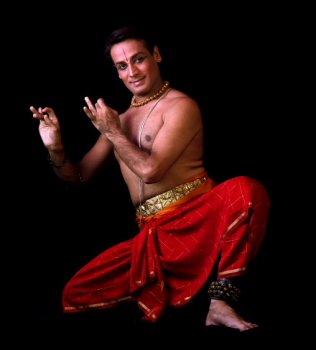
|   |

|   |
Satya's growth graph zooms - Jyothi Raghuram e-mail: jyothi.r.ram@gmail.com December 26, 2012 In the three-piece recital, the Tanjore Quartet varnam "Swami Ninne" and the Ramadasa keerthana "Ye tee ruga" (Naadanaamakriye) were essentially bhakti oriented. They were also items that one has seen Bharatanatyam dancer Satyanarayana Raju present not too long ago. So was the case with his tillana in Rathipathipriya. (This is not to say that there is a limitation to his repertoire). Yet his recital the other day at the Seva Sadan, Bangalore, was a vastly fulfilling experience that had variety in emotions, and bore no mark of being repetitive or monotonous. Satya has been much feted and toasted in recent times, suddenly being catapulted to name and fame. His image now is not just as a performer, but as an important figure on the dance scene.  It sounds ironic that such recognition has come to a dancer who quietly put up a music and dance festival Sanskriti for 15 years, with no sponsorship and spending out of his pocket, and which he was compelled to discontinue for want of funds. One calls it ironic because of the low profile Satya has maintained all along, while also using his dance for social causes such as providing a monthly pension for the stigmatized widows of Brindavan. He was unsung all along. There is a reason for writing about this in a dance review. At some point of time, unless there is a personal growth of the individual, his/her dance will stagnate. It will also reflect in an inability to transcend from the mundane, to the profound. Satya's blossoming into a dancer with an amazing ability to move his audience through his emoting, his exceptionally neat nritta, topped by a stately stage presence, has gone hand in hand with the maturing of his persona--affable and helpful that he is known to be. The Ashtaragamalika varnam, with its portrayal of Shiva-Parvathi as an aside, more than revealed the array of expressions this dancer is capable of. His interchanging stances for this revealed several other dimensions of his potential. The Ramadasa piece also did not confine to devotion alone. This is Satya's masterpiece, in fact, for its deeply-touching Shabari episode, the entire sanchari conceptualized so naturally as to make it appear utterly simple. Without wanting to use superlatives, one has to mention that this is one dance number of Satya that has to be watched by every dancer, including the veterans. The tillana again was a rich mosaic of movements, practically everything falling into place, from the consistent aremandi to the completion of every adavu in all neatness. A quiet dignity continues to mark the presence of this very attractive dancer, who is at once macho and graceful. Having unobtrusively broken into the pantheon of female dancers, this male dancer commands attention as a soloist, whose dance makes for compulsive viewing. Heading the music support was Shakuntala R Prabhat. Her nattuvangam is steady and supportive. Vocalist Karthik Hebbar has a sound grounding, but one has to wait and see if he can strike a rapport with the dancer. Lingaraj on the mridangam and Narasimha Murthy on the flute completed the ensemble. The recital was part of Ananya's Nritya Neerajana arts festival. Jyothi Raghuram is a journalist with over two decades experience in both the print and electronic media, having worked with news organizations such as PTI, The Hindu and Indian Express. Her specialized writings on the performing and visual arts have been considered as benchmarks for their comprehensive and in-depth dealing of the subjects. |